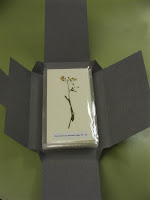NLS Conservation
Friday, 20 May 2011
The Conservation of Caroline Lamb's Commonplace Book
Conservation of Commonplace Book
The Elizabeth Soutar Bookbinding Competition
Creative and craft binding categories
This competition aims to encourage the practice and development of both creative and craft binding skills which display individual expression and originality. The judges look for a best creative and a best craft binding. Each category carries two prizes - a main prize of £1,200 and a student prize of £600.
We define a student as any person receiving full or part-time training or education in bookbinding. We consider all student entries for both the main and student categories, but they are only eligible for one prize.
Exclusive binding
We ask entrants to submit a binding that has been bound exclusively for this competition using materials of their own choice. The winning entries join our collection of fine bindings.
Mrs Elizabeth A Clark (formerly Soutar) of Moray sponsored the award from 1993 until her death in 2008. Thanks to a bequest from her, the competition continues.
The closing date for the 2011 competition is 14 November. We will announce the winners towards the end of the year.
Photographs of previous entries
Thursday, 19 May 2011
How to make a simple pamphlet binding.
Wednesday, 4 May 2011
NLS Handling Guidelines

Guidelines for Handling NLS Material
General Guidelines
- Ensure you have a clear, clean workspace before fetching material.
- Always make sure your hands are clean and dry. Wash hands frequently while working with material. Gloves are not necessary unless you are handling photographic material.
- Remove bulky and sharp jewellery. Do not use hand cream while handling material.
- Do not eat or drink while handling material.
- Only use pencil, never pens or markers.
- Do not use Post-it Notes, paperclips, or Blu-tack on material.
- Always remove books from shelves by grasping sides of spine, never by the headcap. If necessary, push the two adjacent books back slightly to get a good grip.
- Use a book pillow or a foam book rest if possible. A snake weight will hold the book open in place.
- If possible, carry the entire archive box to your work area. Remove folders from box one at a time. Keep folders flat as you move them.
- Do not carry single loose sheets. If you must move a single sheet, place it on a piece of stiff paper or card and hold two corners.
- Always keep loose sheets in order.
- Ensure your work area is clear enough to accommodate the open folder. Do not open folders on top of other material.
- Lift large folders by holding opposite corners, allowing the folder to droop in a gentle arc between your arms.
Thursday, 28 April 2011
19th Century Naturalist Notebook with Specimens
 This notebook was owned by the 19th Century poet, preacher, and naturalist, George Crabbe. The binding was damaged, and split along the joint, and some of the sections were loose. However, of most concern were the loose plant and insect specimens that were pressed between the pages
This notebook was owned by the 19th Century poet, preacher, and naturalist, George Crabbe. The binding was damaged, and split along the joint, and some of the sections were loose. However, of most concern were the loose plant and insect specimens that were pressed between the pages


 The specimens were mounted to white acid-free card using delicate thread and small stitches, and encapsulated within polyester envelopes. A four-flap enclosure was made to house the specimens together.
The specimens were mounted to white acid-free card using delicate thread and small stitches, and encapsulated within polyester envelopes. A four-flap enclosure was made to house the specimens together.
The binding after treatment

The book housed within a new custom drop-spine box with the mounted specimens.
19th Century French Panorama
 This 19th Century French Panorama came to the workshop in two pieces, the paper having split along the folds of the accordian in several places. The edges and corners of the boards were also badly worn, and the entire object was covered with light surface dirt.
This 19th Century French Panorama came to the workshop in two pieces, the paper having split along the folds of the accordian in several places. The edges and corners of the boards were also badly worn, and the entire object was covered with light surface dirt. Treatment invoved surface cleaning (taking extra care around the delicate cut-out images), repairing the folds with Japanese paper and wheat starch paste, consolidating the board corners and repairing the board edges with Japanese paper toned to match the covering paper, and wheat starch paste.
Treatment invoved surface cleaning (taking extra care around the delicate cut-out images), repairing the folds with Japanese paper and wheat starch paste, consolidating the board corners and repairing the board edges with Japanese paper toned to match the covering paper, and wheat starch paste. 
Repair of the board edges with Japanese paper.




